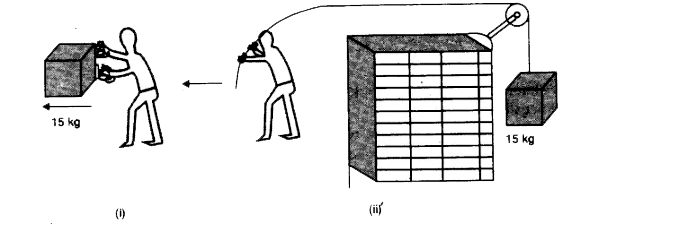An artificial satellite orbiting the earth in very thin atmosphere loses its energy gradually due to small but continuous dissipation against atmospheric resistance. Then explain why its speed increases progressively as it comes closer and closer to the earth.
Kinetic energy increases, but potential energy decreases, and the sum decreases due to dissipation against friction.
Topper's Solved these Questions
- GRAVITATIONBOOK - MOTIONCHAPTER - GRAVITATIONEXERCISE - Exercise - 1 (Section - A :- Newtons Law of Gravitation & Gravitational Field, Potential and Potential Energy)
28 Videos
- GRAVITATIONBOOK - MOTIONCHAPTER - GRAVITATIONEXERCISE - Exercise - 1 (Section - B :- Gravitational Acceleration and Its Variation)
20 Videos
- GRAVITATIONBOOK - MOTIONCHAPTER - GRAVITATIONEXERCISE - Exercise - 4 | Level - II (Previous Year | JEE Advanced)
15 Videos
- GEOMETRICAL OPTICSBOOK - MOTIONCHAPTER - GEOMETRICAL OPTICSEXERCISE - Exercise - 4 | Level-II
55 Videos
- HEAT - 1BOOK - MOTIONCHAPTER - HEAT - 1EXERCISE - EXERCISE -4 (Level - II) Previous Year | JEE Advanced
22 Videos
Similar Questions
Answer the following:
a) The casing of a rocket in flight burns up due to friction. At whose expense is the heat required for burning obtained? The rocket or the atmosphere?
b) Comets move around the sun in highly elliptical orbits. The gravitational force on the comet due to the sun is not normal to the comet's velocity in general. Yet the work done by the gravitatonal force over every complete orbit of the comet is zero. Why?
c) An artificial satellite orbiting the earth in very atmosphere loses its energy grdually due to dissipation against atmospheric resistance, howerver small. Why then does its speed increase progressively as it comes closer and closer tothe earth? d)In fig i) the man walks 2m carrying a mass of 15 kg on his hands. In Fig ii) he walks the same distance pulling the rope behind him. The rope goes over pulley, and a mass of 15 kg hangs at its other end. In which case is the work done greater?

View SolutionAnswer the following:
a) The casing of a rocket in flight burns up due to friction. At whose expense is the heat required for burning obtained? The rocket or the atmosphere?
b) Comets move around the sun in highly elliptical orbits. The gravitational force on the comet due to the sun is not normal to the comet's velocity in general. Yet the work done by the gravitatonal force over every complete orbit of the comet is zero. Why?
c) An artificial satellite orbiting the earth in very atmosphere loses its energy grdually due to dissipation against atmospheric resistance, howerver small. Why then does its speed increase progressively as it comes closer and closer tothe earth? d)In fig i) the man walks 2m carrying a mass of 15 kg on his hands. In Fig ii) he walks the same distance pulling the rope behind him. The rope goes over pulley, and a mass of 15 kg hangs at its other end. In which case is the work done greater?

View Solution
Knowledge Check
A satellite going round the earth in a circular orbit loses some energy due to a collision. Its speed is υ and distance from the earth is d.
Ad will increase, υ will increaseBd will increase, υ will decreaseCd will decrease, υ will decreaseDd will decrease, υ will increase.When a satellite in a circular orbit around the earth enters the atmospheric region, it encounters small air resistance to its motion. Then
Aits kinetic energy increasesBits kinetic energy decreasesCits angular momentum about the earth decreasesDits period of revolution around the earth increasesAn artificial satellite of Earth nears the end of its life due to air resistance. While still in orbit:
AIt moves faster as the orbit lowerBIt moves slower as the orbit lowersCIt slowly spirals away from EarthDIt moves slower in the same orbit but with a decreasing period
An artificial satellite in the presence of frictional forces will move into an orbit closer to the earth and may have increased kinetic energy. Explain this.
View SolutionThe artificial satellite does not have any fuel, but even then, it remains in its orbit around the earth. Why?
View SolutionDiameter of a planet is 10d∘, its mean density is ρ∘4 and mass of its atmosphere is 10m∘ where d∘, ρ∘ and m∘ are diameter, mean density and mass of atmosphere respectively for the earth. Assume that mean density of atmosphere is same on the planet and the earth and height of atmosphere on both the planets is very small compared to their radius. Find the ratio of atmospheric pressure on the surface of the planet to that on the earth. If a mercury barometer reads 76 cm on the surface of the earth, find its reading on the surface of the planet.
View SolutionAn artificial satellite moving in a circular orbit around the earth has a total energy E0. Its potential energy is
View SolutionWhen a satellite going around the earth in a circular orbit of radius r and speed v loses some of its energy, then
View Solution
